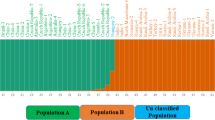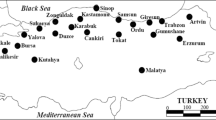Abstract
The importance of germplasm characterization is an important link between the conservation and utilization of plant genetic resources in various breeding programmes. In the present study, genetic variability and relationships among twenty-four Capsicum annuum L. genotypes were tested using PCR-based RAPD and ISSR molecular markers. The level of polymorphism across genotypes was 42–44 % as revealed by RAPD and ISSR, respectively. The highest similarity was detected between PC-1, Feroz, Gajio, Kandaghat Selection-9 genotypes (96 %) and Feroz, Kandaghat Selection-9 (93 %), by RAPD and ISSR markers, respectively. It was concluded from the pooled analysis of both molecular markers that genotypes ACC-2 and Mahog were most distantly related to each other. Hence, it is recommended that these two genotypes should be crossed to create a segregating population with maximum genetic diversity. Further, it is suggested that molecular markers are valid tags for the assessment of genetic diversity in C. annuum germplasm.



Similar content being viewed by others
References
Vyrodova AP, Andryshchenka VK, Zatuliveter VI (1988) Content of beta carotene in various vegetables. Fjiziologiya Bikohimiya Kultrunykh Rasteni 20:167–171
Maric S, Bolaric S, Martincic J, Pejic I, Kozumplik V (2004) Genetic diversity of hexaploid wheat cultivars estimated by RAPD markers, morphological traits and coefficients of parentage. Plant Breed 123:366–369
Paterson AH, Tanksley SD, Sorrells ME (1991) DNA markers in plant improvement. Adv Agron 46:39–90
Rafalski JA, Vogel JM, Morgante M, Powell W, Tingey CS (1996) Generating and using DNA markers in plants, in non mammalian genomic analysis: a practical guide. In: Birren B, Lai E (eds). Academic Press, New York, p 73–134
Ryzhova NN, Kochieva EZ (2004) Analysis of microsatellite loci of the chloroplast genome in the genus Capsicum (pepper). Russ J Genet 40:892–896
Doyle JJ, Doyle JJ (1990) Isolation of plant DNA from fresh tissues. Focus 12:13–15
Williams JGK, Kubelik AR, Ratalski KJ, Tingey SV (1990) DNA polymorphisms amplified by arbitrary primers are useful as genetic markers. Nucleic Acids Res 18:6531–6535
Rohlf FJ (1998) NTSYS-pc: numerical taxonomy and multivariate analysis system. Version 2.02e. Exeter publications, Setauket
Nei M, Tajima F, Tateno Y (1983) Accuracy of estimated phylogenetic trees from molecular data. J Mol Evol 19:153–170
Bhadragoudar MR, Patil CG (2011) Assessment of genetic diversity among Capsicum annuum L. genotypes using RAPD markers. Afr J Biotechnol 10:17477–17483
Yumnam JS, Tyagi W, Pandey A, Meetei NT, Rai M (2012) Evaluation of genetic diversity of chilli landraces from north eastern India based on morphology, SSR markers and the Pun1 locus. Plant Mol Biol Rep 30:1470–1479
Thul ST, Darokar MP, Shasany AK, Khanuja SPS (2012) Molecular profiling for genetic variability in capsicum species based on ISSR and RAPD markers. Mol Biotechnol 51(2):137–147
Sitthiwong K, Matsui T, Sukprakarn S, Okuda N, Kosugi Y (2005) Classification of pepper (Capsicum annuum L.) accessions by RAPD analysis. Biotechnology 4:305–309
Rad MB, Hassani ME, Mohammadi A, Lessan S, Zade SG (2009) Evaluation of genetic diversity in Capsicum spp. as revealed by RAPD markers. Acta Hortic 829:275–278
Sanatombi K, Sen MS, Sharma GJ (2010) DNA profiling of Capsicum landraces of Manipur. Sci Hortic 124:405–408
Lijun O, Xuexiao Z (2012) Inter simple sequence repeat analysis of genetic diversity of five cultivated pepper species. Afr J Biotechnol 11:752–757
Patel AS, Sasidharan N, Vala AG, Vinay K (2011) Genetic relation in Capsicum annuum L. cultivars through microsatellite markers: SSR and ISSR. Electron J Plant Breed 2:67–76
Olmstead RG, Sweere JA, Spangler RE, Bohs L, Palmer JD (1999) Phylogeny and provisional classification of the solanaceae based on chloroplast DNA. In: Nee M, Symon DE, Jessup JP, Hawkes JG (eds) Solanaceae IV advances in biology and utilization. Royal Botanic Gardens, Kew, London, pp 111–137
Knapp SL, Bohs MN, Spooner DM (2004) Solanaceae: a model for linking genomics with biodiversity. Comput Funct Genomics 5:285–291
Gopinath K, Radhakrishnan NV, Jayaral J (2006) Effect of propiconazole and difenoconazole on the control of anthracnose of chilli fruit caused by Colletotrichum capsici. Crop Prot 25:1024–1031
Acknowledgments
Authors are thankful to Department of Science & Technology (DST), New Delhi whose equipment facilities provided in one of the ongoing research project are fully utilized for carrying out molecular characterization work.
Author information
Authors and Affiliations
Corresponding author
Rights and permissions
About this article
Cite this article
Rana, M., Sharma, R., Sharma, P. et al. Estimation of Genetic Diversity in Capsicum annuum L. Germplasm Using PCR-Based Molecular Markers. Natl. Acad. Sci. Lett. 37, 295–301 (2014). https://doi.org/10.1007/s40009-014-0236-5
Received:
Revised:
Accepted:
Published:
Issue Date:
DOI: https://doi.org/10.1007/s40009-014-0236-5




